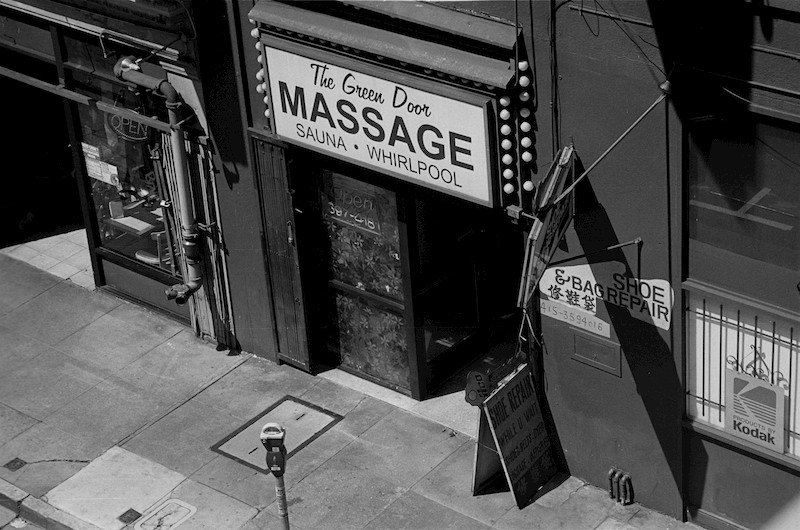Adam, Tri X is the king of B&W film. As long as you do not develop yourself, either shoot the chromogenics ( expose at EI 200 and develop normally) or shoot Tri X exposed normally, or even slightly underexposed, as for scanning you do not want an overly dense negative. In full sun however, it would be better to shoot 1/250 f 16 in order to avoid black shadows.
For developing, I will distill in a couple of lines what I have come up to after a few years of experimenting:
you will need
- a changing bag (or a dark closet)
- one steel tank for 4 35mm reels with a rod on which you pile the reels
- 4 Hewes stainless 35mm reels
3 1 litre plastic measuring jars
a couple of liters of DD-X Ilford developer
a couple of liters of concentrated fixer of any major brand
a bottle of photo flo
a 1 liter bottle of denaturated alcohol
a 5 liter canister of demineralized water
a precision darkroom thermometer
2 100 cc plastic measuring cylinders
8 metal hanging film clips
2 cheap kitchen timers
Get some red and blue tape, and mark the 1 liter jugs at a level where the liquid will be sufficient to cover the reels in the tank ( for me it is 900cc), the red one for developer, blue one for fixer, you can mark the third jug with white tape - it will be used for the final rinse. Mark with red and blue the smaller cylinders too, so that you will know which is which and will avoid the risk of contamination.
I use DD-X 1+9, this way it is easier to control the time and it is also cheaper. This developer with Tri X gives full tonality and full speed, plus good sharpness, plus is easy to prepare, as it comes in a liquid form. In my opinion it is the best compromise overall.
I normally pour it into smaller bottles after opening. to avoid oxidation.
So, to prepare the development, first you have to load the film onto the reels and into the tank. I use a 4 reel tank, because in the end it is the best compromise between convenience, temperature stability and lazyness. You might also get a 2 reel tank if you need to develop less film quickly.
Yoy pour 90cc of DD-X onto the "red" jug, and you add DEMINERALIZED water to make 900cc, then you pour some concentrated fixer into the "blue" jug (according to instructions - for me it is about 116 cc) and add TAP water, to make 900cc again, then you pour some alcohol (100cc) in the "white" jug, you add a FEW drops of photo flo, and fill up with DEMINERALIZED water for the final rinse.
Then you pour water at 20deg C into a sink, plug it, and you immerse both jugs for half an hour, to let them stabilize the temperature. You set the timers for 9 minutes and 5 minutes respectively.
After the temperature is ok, you pour the developer into the tank (skew the tank slightly to avoid bubbles), tap it and start the timer, and invert up and down 4 times. As you invert, rotate the tank each time half a twist TOWARDS YOU.
Then hit the bottom of the tank against a hard surface 4 times to dislodge the bubbles, and leave it alone till you see 8 minutes 00 on the timer. You twist the tank 4 times again, and hit it again to dislodge the bubbles, you repeat this each minute till the end. When the timer beeps, you pour out the developer,and pour in the fixer.
Start the 5 minutes timer, and this time invert the tank for 30secs and let it rest for 30 secs each minute. During the last minute, open running water from the tap, and adjust the temperature, so that it is at 20 deg C ( plus or minus 2 deg).
When the 5 minute timer beeps, open the tank, pour out the fixer, and place it under running tap water, fill up agitating with the rod, and pour out 3 times in a row. Then place it under the tap again and start the 5 min timer again. When it beeps, pour out the water, pour in the liquid from the "white" jug, and agitate a few times.
Finally, you have to find a place to hang the negatives (shower is ideal). After you have hooked up the negs on the clips and hung them up, you use the liquid in the tank to rinse them over from both sides, and then you grab the clips at the bottom and pull them all to a side for a minute, to let the liquid slide down along the edges of film. Then you let it dry for a few hours without generating the dust, so it is best to close the doors and windows if any,
That's it.


